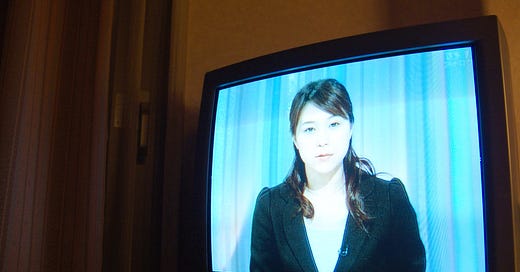"TOKYO stay - beautiful newscaster" by MIKI Yoshihito. (#mikiyoshihito) is licensed under CC BY 2.0
Conspiracy theorists often talk about “the lamestream media.” We have seen that it should be a red flag when someone tells you to stop consuming the news - they might be some kind of guru or about to sell you a fringe view. However, that doesn’t mean that the news media should be above criticism. We can respect the insight that something about the news feels slightly off to many people without necessarily accepting a conspiratorial explanation of what it is. Trust in the media is at an all-time low and journalists have a duty to look for solutions and listen to our critics.
I suspect that conspiracy theorists tend to be mostly thinking about the television news when they criticize the media, so today’s blog will focus on this area. Although I have appeared as a talking head a few times over the years, I have spent my whole career as a journalist in international media specializing in newswires and subscription service, so this is slightly outside my area of expertise. My suggestions are meant to be taken as an inspiration for discussion and experimentation rather than anything more definitive. Also, I am aware of the old joke in journalism that the answer is “no” if a headline asks a question!
Television has changed enormously in the last couple of decades. TV series used to be shallow and unfulfilling. This began to change with The Sopranos in 1999, which broke new ground in many areas. More recently, we have seen a serious commitment to character development in Breaking Bad (2008 to 2013); multiple viewpoints and moral ambiguity in Game of Thrones (2011 to 2019); and unexpected changes of perspective in Westworld (from 2016). I’m sure we can all think of many more examples.
Despite this innovation elsewhere on TV, the evening news has remained mostly unchanged. The style was set in the 20th century: Serious figures in smart clothes present information with an authorative tone and then cut to colleagues on the ground, who present a summary of local information while trying to maintain a poker face. Experts drop in and out. The structure of the programme remains largely the same unless there is some major news that needs more time and squeezes out other segments.
Anyone who has ever been in a newsroom knows that the behind-the-scenes reality is somewhat different: Chaos, stress, near-misses, back-up plans and improvisation. And yet the viewer doesn’t get to see any of this, other than occasional connection issues with reporters in far-off places. Could the smooth presentation of inherently messy material be troubling for people who are drawn to conspiracy theories? Would people trust the TV news a little more if journalists broke the fourth wall once in a while?
I don’t know the answers to my questions, but I would love to see a little more experimentation with formats. Imagine a short section before the weather that talks about how the team made the judgement calls about what went into the evening news and what didn’t. Imagine reporters dropping their poker faces once in a while and honestly expressing their emotions; or spending as much time talking about what they don’t yet as what they do know. Would it help improve trust in the media? Maybe it would and maybe it wouldn’t, but shouldn’t we try and find out the answer?
If you have enjoyed today’s blog, I would appreciate if you could share it on social media. Anyone who wants to discuss it further can drop me a line at sharpenyouraxe at substack.com of find me at Twitter. Finally, you can find the beta version of my free book on thinking critically about current affairs here. See you next week!
[Updated on 10 March 2022] Opinions expressed on Substack and Twitter are those of Rupert Cocke as an individual and do not reflect the opinions or views of the organization where he works or its subsidiaries.



